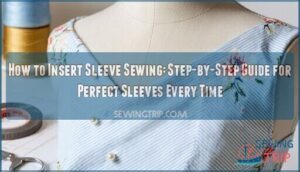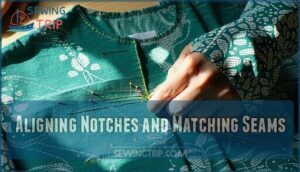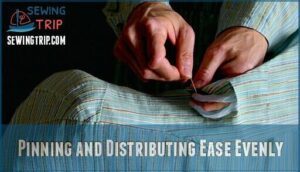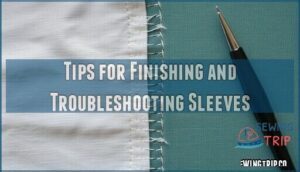This site is supported by our readers. We may earn a commission, at no cost to you, if you purchase through links.
 If you’re wondering how to insert sleeve sewing without wrestling your fabric into a wrinkly mess, start by making sure your sleeve is cut on the right grain and the notches are marked.
If you’re wondering how to insert sleeve sewing without wrestling your fabric into a wrinkly mess, start by making sure your sleeve is cut on the right grain and the notches are marked.
Pin the sleeve’s notches to your armhole, matching seams and easing in any extra fabric with long, loose basting stitches. Use a tailor’s ham to press and shape the sleeve cap for a smooth fit—think of it as coaching the fabric to behave.
Stitch it in place with care, and take a moment to admire your work. Curious about fixing wonky seams or pro tricks? Stay tuned.
Table Of Contents
Key Takeaways
- Match sleeve and armhole notches exactly, and use pins to keep everything aligned for a smooth join.
- Use basting stitches to ease extra fabric and prevent puckers or gathers from ruining your finish.
- Press the sleeve cap on a tailor’s ham before and after sewing to shape it and get crisp results.
- Try the flat method for sleeves if you’re working with knits—it’s simpler and reduces frustration with curved seams.
How to Prepare Sleeves for Sewing
Before you start sewing, make sure your sleeves are cut accurately, marked with notches, and basted for ease—nobody wants a wrinkled underarm surprise later.
Well-cut, clearly marked sleeves are your secret to smooth sewing—because nobody deserves a wrinkled underarm surprise
Taking the time now to press and shape the sleeve cap will help everything fit together smoothly, even if it feels like your fabric is determined to test your patience.
Choosing The Right Sleeve Style
When picking sleeves, think about Sleeve Functionality and the vibe you want.
Set-in sleeves give structure—great for sharp shirts.
Raglan sleeves offer easy movement, a solid choice if you’re always on the go.
Let Fabric Choice and Body Shape be your guides, but mix in Occasion Appropriateness and Personal Style.
The sleeve cap shape really makes a difference!
Cutting and Marking Sleeves Accurately
Once you’ve picked the sleeve style, grab your sharpest cutting tools and double-check pattern accuracy.
Line up grainlines so the sleeves hang right, and pay close attention to notch placement—those little marks will be lifesavers.
Mark all sleeve and armhole notches clearly, since they guide you later.
Careful fabric preparation makes everything, from the sleeve cap to side seams, much simpler.
When working with delicate materials, consider stabilizing the fabric to prevent slippage.
Adding Basting and Ease Stitches
Once your sleeve’s been cut and marked, it’s time to talk basting stitches.
Set your machine’s stitch length to 4–6 mm, use a contrasting thread, and work gather stitches along the seam line and inside it.
Lightly pull bobbin threads to control ease distribution.
Mind thread tension—too tight, and you’ll wrinkle the fabric instead of easing it.
This technique temporarily holds fabric, making it ideal for temporary seam placement, which is useful for ease distribution and seam placement.
Pressing and Shaping The Sleeve Cap
Almost always, reaching for a tailor’s ham pays off when shaping the sleeve cap.
Light steam helps mold fabric resilience, while easing at the sleeve head smooths out lumps.
Don’t skip checking grain alignment—it keeps those sleeves balanced, not lopsided like a badly parked car.
Using one helps achieve professional results, so consider purchasing a quality ham.
Use shaping tools wisely, and press seam allowances open for a crisp, pro look.
How to Sew Sleeve Seams Properly
When you’re ready to sew sleeve seams, you’ll want to match your underarm edges precisely and pin them securely, so nothing shifts while you stitch.
Taking the time to press your seams crisp and flat can make your sleeves look so smooth, even your iron might start feeling proud.
Matching and Pinning Underarm Seams
Even if you’re all thumbs, seam alignment at the underarm is your secret weapon.
Match the sleeve seam with the garment’s side seam, right sides together, for a neat underarm pivoting point.
Use pinning techniques along the armhole and sleeve to prevent slippage, and distribute ease evenly so your insert sleeves settle smoothly with no lumps or bumps.
Mastering the backstitch technique guarantees a strong and versatile seam.
Stitching and Finishing Seam Allowances
Once you’ve pinned the underarm seam, stitch the sleeve seam smoothly, keeping those notches lined up.
Trim or grade seam allowances to reduce bulk, especially at the armhole seam. Use clipping curves to help the sleeve lay flat.
Finish edges with bias binding or zigzag stitching to prevent fraying. Understitching can help keep seam allowances tidy—think of it like herding cats! Use bias binding to achieve a professional finish.
Pressing Techniques for Crisp Seams
With the right pressing tools and a trusty tailor’s ham, you’ll shape those sleeve seams for a crisp finish.
After sewing techniques are complete, press seam allowances open or toward the sleeve, depending on fabric type.
Under pressing with plenty of steam sets the seam, locks in shape, and makes installing a sleeve look tidy and controlled.
Step-by-Step Guide to Inserting Set-in Sleeves
Getting a set-in sleeve to look just right takes careful steps, but you’ll soon see how smooth the process can be.
Follow along, and you’ll have sleeves that sit perfectly on your shoulders—no puckers, no surprises, and only a few pins lost to the fabric, with a result that is smooth.
Aligning Notches and Matching Seams
Picture your sleeve as a puzzle piece—Notch Accuracy is key for Seam Alignment.
Find the notches and matching points marked on both the sleeve and armhole.
Line them up, matching seams and seam allowance without guessing.
This step helps prevent mismatch, keeps ease distribution tidy, and sets the stage for smooth, professional-looking sleeves every single time, ensuring Seam Alignment.
Pinning and Distributing Ease Evenly
When you go to pin in your sleeve, start by grabbing those notches and matching them with your armhole—don’t rush.
Use sleeve side pinning to anchor the underarm seam first, then work your way around, evenly spacing pins to distribute ease.
Gentle easing helps the sleeve head curve smoothly, which keeps tucks and lumps from sneaking in.
Machine Stitching for Best Results
On a good day with your sewing machine, smooth sleeve stitching feels as satisfying as a perfect pancake flip.
To sew sleeves the best way:
- Use a 2.0–2.5mm stitch length and a sharp needle type for control.
- Adjust thread tension for set-in sleeves.
- Let feed dogs guide evenly.
- Lower presser foot pressure—no sleeve drama!
To prevent fabric fraying, consider binding and facing for a professional finish, and remember, smooth sleeve stitching feels as satisfying as a perfect pancake flip.
Flat Sleeve Insertion Method Explained
With the flat sleeve insertion method, you’ll attach the sleeve to the armhole before sewing the side seams, making things much easier to handle.
If you’ve ever tried to wrangle a sleeve into place and ended up in a fabric wrestling match, this approach is about to be your new best friend.
When to Use The Flat Method
If you’re tackling knit fabrics or casual garments, the flat sewing method’s your secret weapon.
With little ease allowance needed and the ability to sew sleeves flat before side seams, it’s perfect for beginner projects and stretch fabrics. Think T-shirts, sweatshirts—attaching sleeves this way is like finding the cheat code to pain-free sleeve insertion.
Remember to evenly distribute pins to manage any excess sleeve fabric during this process.
————-:
—————:
———————:
Pinning Sleeves Before Side Seams
When working with the flat insertion method, pinning sleeves before closing side seams is a breeze—think of it as putting together a sandwich, with perfect notch alignment and even ease distribution.
Pinning from the center out, letting the fabric sit naturally, gives you better seam control and helps sleeves, especially in knit fabrics, lay smoothly on the armhole.
To achieve a professional finish, remember to:
- Match all notches precisely
- Pin from shoulder to underarm
- Adjust ease evenly, ensuring a smooth and even distribution of fabric for a perfect fit, with better seam control.
Sewing Sleeves in Knit and Casual Garments
When you sew sleeves on knit garments or casual sleeve styles, the flat sleeve method is your trusty sidekick.
Attach sleeves before the side seams—this skips the wrestling match with set-in sleeve curves.
Stretch fabric sleeves need less fuss about ease, helping you get that comfortable sleeve fit fast.
Flat sleeve benefits? Less puckering, more smiles.
Tips for Finishing and Troubleshooting Sleeves
You’ve almost finished your sleeves, but the final touches can make all the difference between a smooth fit and a puckered mess.
Let’s cover a few smart fixes and finishing tricks so you won’t end up wrestling your shirt into submission.
Trimming, Grading, and Seam Finishing
Sharp scissors are your best friend for seam allowance trimming—snip extra width to about 1/4 inch to cut bulk at the armhole.
Grading techniques help smooth things out: trim each layer to a different width.
For professional finishes and to prevent fraying, use a zigzag or serger.
Clean seams mean your set-in sleeve really looks like something you’d buy, and many sewers find specialized trimming tools helpful for this task to achieve a clean finish.
Pressing for a Professional Look
A tailor’s ham is your best friend for pressing sleeve heads, set-in sleeves, and preserving shape retention.
Start with under pressing from the seam allowance, then move to top pressing for a crisp finish.
Keep the iron moving, don’t squish the curve, and let the steam do its magic—your sleeves will look sharp and stay comfortable after inserting sleeves.
Using a bamboo point presser can further refine edges.
Fixing Common Sleeve Issues (Puckering, Twisting)
Ever finish a sleeve only to spot puckering or a weird twist?
Here’s how to fix it:
- Check for notch mismatch and adjust so the sleeve and armhole align.
- Distribute easing and gather stitches evenly, balancing sleeve fullness.
- Reduce thread tension and press seams to tackle puckering causes.
Tackle twisting solutions quickly—don’t let uneven gathers mess up your masterpiece! To ensure a smooth finish, consider the causes of puckering and address them promptly.
Practice Patterns and Fabric Considerations
After fixing sleeve puckers or twists, it’s smart to practice with patterns like the York Top, Reggie Dress, or Kenedy Dress.
Your fabric choice—whether working with woven fabrics or knits—can make or break your confidence with set-in sleeve sewing patterns.
Seam finishing methods and a bit of patience go a long way for any garment.
| Pattern | Fabric Choice | Seam Finishing |
|---|---|---|
| York Top | Cotton, Linen | Zigzag, Serged |
| Reggie Dress | Voile, Chambray | French Seam |
| Kenedy Dress | Muslin, Jersey | Clean Finish |
The table provides a summary of the patterns, fabric choices, and seam finishing methods, highlighting the importance of seam finishing methods and fabric choice in garment construction.
Frequently Asked Questions (FAQs)
What is the purpose of using a sleeve roll in sleeve insertion?
A sleeve roll lets you press curved seams, keeping the sleeve’s shape smooth while avoiding creases where you don’t want them.
Think of it as giving your sleeve a mini ironing board just its size—no flat spots, which can be considered a mini ironing board for the sleeve.
Are there any alternative methods for inserting sleeves?
There’s more than one way to skin a cat—try the flat method, where you attach the sleeve before sewing side seams.
Or use raglan-style sleeves, which skip easing altogether and make construction a breeze for beginners.
How do you determine the correct sleeve and armhole alignment?
First, match the notches on your sleeve and armhole—they’re like little road signs.
Line up the underarm seams, double-check both sides’ notches, and use pins.
This helps prevent twisting, puckers, or embarrassing sleeve mishaps, by ensuring complete concepts are followed, and using pins to secure the fabric in place.
What should you do if there are pleats or puckers in the gathered fabric?
Did you know fabric gathers best when you keep basting stitches even?
If pleats or puckers pop up, gently loosen the stitches, redistribute the gathers with your fingers, and press lightly—don’t let those sneaky folds steal your thunder!
Can you sew shirt sleeves with ease instead of on the flat?
You can sew shirt sleeves with ease instead of on the flat—just prep with basting stitches and gently gather the cap to fit the armhole.
It’ll give you a sharper, polished finish, minus the dropped-shoulder vibe.
How to adjust sleeve length after sewing?
Picture your sleeve as a pant leg that’s a tad too long.
To fix it, rip the hem, fold the fabric to your new length, pin, press, and sew it back down.
Nothing says “tailored” like custom sleeves!
What tools help insert sleeves more easily?
You’ll get the smoothest sleeve insert with pins, sharp scissors, a seam ripper, tailor’s chalk, and a good pressing tool like a tailor’s ham.
A walking foot or sleeve board also makes life easier and seams straighter.
Can interfacing improve sleeve cap structure?
Adding a strip of lightweight interfacing to the sleeve cap helps the fabric hold its shape, banishes those pesky puckers, and gives your sleeve head some backbone.
Especially handy if your fabric’s on the floppy side.
How to handle sleeves with decorative trims?
Just when you think you’re almost done, that trim arrives—ready to challenge your patience.
Attach trims before setting in the sleeve, press carefully, and pin with extra care so everything lines up when you stitch.
Best techniques for inserting sleeves in lined garments?
Inserting sleeves in lined garments works best when you attach the sleeve to the outer fabric first, then insert the lining separately.
This keeps seams tidy, reduces bulk at the armhole, and saves you from headache later.
Conclusion
Did you know that smooth sleeve insertion can reduce garment puckering by up to 80%?
If you follow these steps on how to insert sleeve sewing, you’ll avoid wrinkly disasters and achieve a crisp, pro finish every time.
Remember, matching notches and using basting stitches matter more than rushing. Even if your first try isn’t perfect, with practice, you’ll master set-in or flat methods.
Keep your seam ripper handy, but trust your steady hands to guide you!
- http://store.pavilionbooks.com/9781909397415-elementary-sewing-skills.html
- http://www.merchantandmills.com/
- http://www.lovecrafts.co.uk/books/elementary-sewing-skills/
- https://coppercreekpatterns.com/blogs/sewing-tools/what-is-a-basting-stitch-and-how-to-sew-one
- https://www.blueprintsforsewing.com/blog/tutorial-setting-in-sleeves














